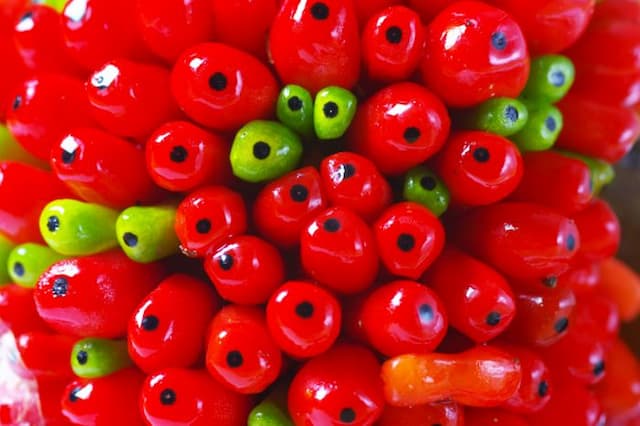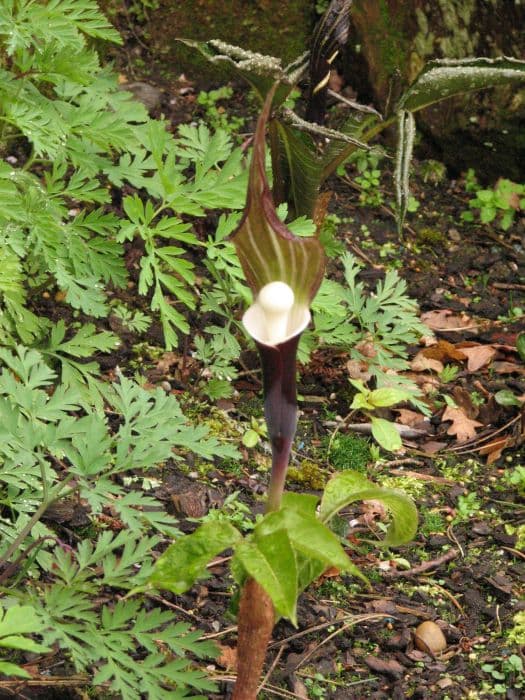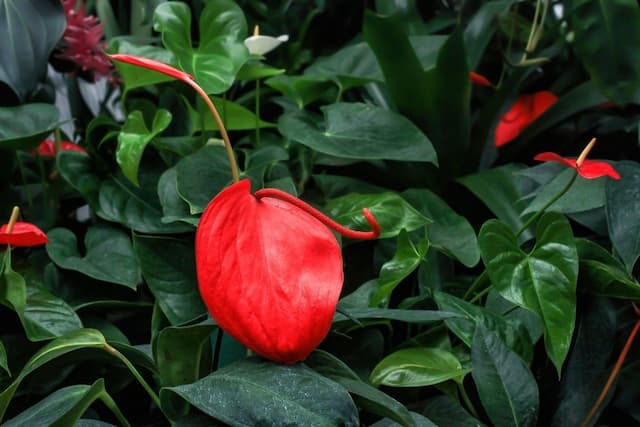Calla Lily 'Morning Sun' Zantedeschia 'Morning Sun' (PBR)

ABOUT
The 'Morning Sun' calla lily is an exquisite ornamental plant with a striking appearance that is bound to draw attention in any garden or floral arrangement. Known for its elegant and funnel-shaped flowers, also called spathes, they possess a sunny hue that transitions from a soft yellow at the edges to a vibrant, golden-orange at the center, much like the colors of a sunrise. The vibrant spathes curve gracefully around a central finger-like floral spike, called a spadix, which is common to this type of plant. The leaves of the 'Morning Sun' calla lily are equally as attractive. They are glossy and arrow-shaped, showcasing a deep green color that often features white or lighter green speckles. These leaves form a lush backdrop that beautifully complements the brilliance of the flowers. The overall presentation of the 'Morning Sun' calla lily is one of sophistication and tropical allure. When in bloom, the combination of its vivid flowers and decorative leaves creates a display of stunning color and textural contrast, making it a favorite for gardeners looking to add a splash of warmth and elegance to their plant arrangements.
About this plant
 Names
NamesFamily
Araceae
Synonyms
Calla Lily, Arum Lily
Common names
Zantedeschia 'Morning Sun' (PBR)
 Toxicity
ToxicityTo humans
The plant commonly known as Calla Lily is considered toxic to humans. The toxicity is due to the presence of calcium oxalate crystals which can cause irritation to the mouth and gastrointestinal tract. If ingested, symptoms can include a burning sensation in the mouth, lips, and tongue, swelling of the throat, difficulty swallowing, and possible nausea, vomiting, and diarrhea. Contact with the eyes can also cause irritation and should be avoided.
To pets
The Calla Lily plant is toxic to pets as well. It contains insoluble calcium oxalate crystals which can lead to oral irritation, intense burning and irritation of the mouth, lips, and tongue, excessive drooling, vomiting, and difficulty swallowing if ingested. In severe cases, ingestion can cause respiratory problems if swelling obstructs the airway. Pet owners should seek veterinary assistance if their pet has ingested any part of the plant.
 Characteristics
CharacteristicsLife cycle
Perennials
Foliage type
Deciduous
Color of leaves
Green
Flower color
Orange
Height
2 feet (0.61 meters)
Spread
2 feet (0.61 meters)
Plant type
Herb
Hardiness zones
8
Native area
South Africa
Benefits
 General Benefits
General Benefits- Ornamental appeal: The 'Morning Sun' variety of calla lily is admired for its distinctive, trumpet-shaped flowers and vibrant coloration, which add aesthetic appeal to any garden or floral arrangement.
- Easy to grow: Calla lilies are known for being relatively easy to cultivate, making them a good choice for beginner gardeners.
- Versatile planting: They can thrive in both pots and garden beds, allowing for flexibility in landscaping design.
- Long blooming period: 'Morning Sun' has a generous blooming period that can extend from late spring into early summer, providing long-lasting color and interest.
- Attracts pollinators: The bright flowers attract bees and butterflies, which are both beneficial for pollination and for the health of the garden.
- Drought-tolerant: Once established, calla lilies can tolerate periods of drought, reducing the need for frequent watering.
- <>Part shade tolerance: 'Morning Sun' calla lilies can tolerate partial shade, which allows them to be planted in a wider range of garden locations.
- Deer resistant: These plants are not preferred by deer, so they are less likely to be damaged in areas with a deer presence.
 Medical Properties
Medical PropertiesThis plant is not used for medical purposes.
 Air-purifying Qualities
Air-purifying QualitiesThis plant is not specifically known for air purifying qualities.
 Other Uses
Other Uses- Photography Prop: 'Morning Sun' callas, with their elegant shape and color, can be used by photographers as a natural prop to add beauty and a pop of color to portrait and wedding photography sessions.
- Craft Material: The sturdy spathes of the calla lilies can be dried carefully to preserve their shape and color, then used in various craft projects such as making bookmarks or added to homemade greeting cards.
- Edible Display: Though not commonly known, the roots of the calla lily can be cooked and eaten in some cultures; however, it's important to note that all parts of the plant can be toxic if not prepared correctly.
- Eco-Friendly Confetti: Dried petals of the calla lily can be used as biodegradable confetti for celebrations, reducing the environmental impact compared to traditional plastic confetti.
- Textile Dye: The pigments in the 'Morning Sun' calla lilies can be used to create natural dyes for fabrics, providing a range of warm, earthy tones.
- Floral Bath: The petals of 'Morning Sun' calla lilies can be floated in a bath for a luxurious, spa-like experience, adding fragrant and visual appeal.
- Artistic Inspiration: The unique shape and color of the 'Morning Sun' calla lily can inspire artists and be used as subject matter for paintings, illustrations, and other forms of art.
- Home Decor: Dried calla lily flowers can be arranged in vases to create long-lasting, low-maintenance floral decorations that add elegance to any room.
- Jewelry Making: Small parts of the calla lily, such as dried petals or rehydrated, pliable stems, can be incorporated into homemade jewelry, like earrings or pendants.
- Color Learning for Kids: The vivid hues of 'Morning Sun' calla lilies can be used as a tool for teaching children about colors and the variations in natural shades.
Interesting Facts
 Feng Shui
Feng ShuiThe Calla Lily is not used in Feng Shui practice.
 Zodiac Sign Compitability
Zodiac Sign CompitabilityThe Calla Lily is not used in astrology practice.
 Plant Symbolism
Plant Symbolism- Purity and Innocence: Calla lilies are often associated with purity due to their white flowers that project a sense of cleanliness and innocence. 'Morning Sun' carries this symbol due to its resemblance to the classic calla lily form.
- Beauty: The unique colors and graceful shape of 'Morning Sun' represent magnificent beauty, often used to convey admiration for someone's refinement and elegance.
- Faith and Holiness: Due to their frequent use in religious ceremonies and the shape that is reminiscent of a trumpet, calla lilies like 'Morning Sun' can symbolize faith and holiness, heralding messages of spiritual importance.
- Resurrection and Rebirth: The flower's shape is also suggestive of trumpets, which are often seen as announcing victory. In a Christian context, this can translate to themes of resurrection, making them suitable for Easter and to represent new beginnings.
- Transcendent Love: 'Morning Sun' with its graceful lines and warmth can evoke feelings of a love that transcends the physical realm, representing an idealized form of love.
- Marriage and Devotion: Because of their association with weddings, calla lilies commonly signify union, loyalty, and long-term commitment, attributes well-suited for celebration of marriage.
 Water
WaterFor the Calla Lily 'Morning Sun', maintain consistency in watering by giving it a thorough soak when the top inch of soil feels dry to the touch, which typically translates to watering once every week. In hot or dry conditions, you may need to water more frequently. When you water, aim to provide about a half gallon per plant, ensuring you moisten the soil deeply to encourage root growth. Avoid letting the plant sit in water as soggy conditions can lead to root rot. During dormant periods in winter, reduce watering significantly, just keeping the soil slightly moist.
 Light
LightCalla Lily 'Morning Sun' thrives in bright, indirect light, making it ideal for placement in spots that receive filtered sunlight, such as near a sunny window with a sheer curtain. Direct afternoon sunlight can be too intense and may scorch the leaves, so aim for a location that offers some protection during peak sun hours. Adequate lighting is crucial for the plant to produce its characteristic flowers.
 Temperature
TemperatureCalla Lily 'Morning Sun' prefers temperatures between 60 to 75 degrees Fahrenheit during active growth. It can survive temperatures as low as 50 degrees Fahrenheit, but it's best to avoid exposure to frost or temperatures below this threshold. During resting periods in the winter, cooler temperatures around 55 degrees Fahrenheit can help the plant to enter dormancy properly.
 Pruning
PruningPruning the Calla Lily 'Morning Sun' is generally done to remove spent flower stems and yellowing leaves to encourage new growth and maintain the plant's appearance. The best time to prune is after the blooms have faded or when the leaves show signs of aging. You can prune as needed throughout the growing season to keep the plant tidy.
 Cleaning
CleaningAs needed
 Soil
SoilCalla Lily 'Morning Sun' thrives best in a well-draining potting mix with a pH of about 5.5 to 6.5. A good recipe is a mix of two parts peat moss to one part perlite or sand to ensure adequate drainage and aeration. Amending with compost can also provide essential nutrients for optimal growth.
 Repotting
RepottingCalla Lily 'Morning Sun' should be repotted every one to two years, or when it outgrows its current container. The best time to repot is in the spring before the growing season begins.
 Humidity & Misting
Humidity & MistingCalla Lily 'Morning Sun' prefers a moderate humidity level around 60-70%. It can tolerate lower humidity but thrives when provided with these conditions, which helps to replicate its native subtropical environment.
 Suitable locations
Suitable locationsIndoor
Provide bright, indirect light and keep soil moist for Calla Lily 'Morning Sun'.
Outdoor
Grow in partial shade, sheltered from wind, and ensure moist soil for Cala Lily 'Morning Sun'.
Hardiness zone
9-11 USDA
 Life cycle
Life cycleZantedeschia 'Morning Sun', commonly known as a Calla Lily, begins its life cycle as a rhizome, planted in early spring. The rhizome sprouts stems and leaves as the temperatures warm, usually by late spring. Lush foliage develops into its full form, followed by the distinctive trumpet-shaped flowers that can range in various colors, typically blooming in late spring to mid-summer. After the flowering period, the plant enters a dormancy phase once temperatures drop in the fall, and the leaves die back. During this dormant period, which occurs in winter, the rhizome survives underground. The cycle repeats when temperatures rise again in the subsequent spring, and the rhizome renews its growth cycle.
 Propogation
PropogationPropogation time
Spring-Early Summer
Zantedeschia 'Morning Sun', commonly known as Calla Lily, is most popularly propagated through division of its rhizomes. The best time to carry out this process is in late winter or early spring, just before the growth season begins. To propagate, carefully dig up the plant and gently separate the rhizomes ensuring that each division has at least one growth point, or "eye." These divided sections can then be replanted in well-draining soil at a depth of about 3 to 4 inches (7.5 to 10 centimeters), spaced approximately 12 inches (30 centimeters) apart to allow for sufficient room for growth. Water the newly planted rhizomes thoroughly after planting to help establish them. This method allows for the rapid increase of your Calla Lily collection and ensures that the new plants will bear the same characteristics as the parent plant.









